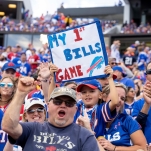DOGE Destroyed America’s Ability to Respond to Myanmar’s Disaster
Photo by Scott Olson/Getty Images
On March 28, a magnitude 7.7-earthquake struck Myanmar (also known as Burma), near Mandalay, the country’s second-largest city. The United States soon dispatched a three-person USAID team to assess the needs in the aftermath of the quake, though the team did not arrive on the ground in Myanmar until days after it.
But once in Myanmar, that USAID team received termination notices, according to current and former USAID officials. USAID sources said at least some of the staffers were believed to have received the news of their firing after sleeping through the night outside in a field.
It is not clear what the actual date of termination was for these USAID employees. In an email, a spokesperson for the State Department did not specifically answer whether the administration had fired the USAID staffers who just landed in a disaster and conflict zone. Instead, the spokesperson indicated that overseas personnel would receive a USAID-funded return, “with a departure that will be considered as the employee’s end-of-tour date.”
“USAID offered significantly longer than required notice periods and is committed to working with employees on these matters,” the spokesperson wrote, adding that USAID’s “top priority is ensuring the continued safety and wellness of our personnel.”
The same day as the earthquake in Myanmar, the Trump administration told Congress it was “realigning“ certain USAID functions within the State Department by July 1. An internal memo sent to USAID staff said the agency was terminating nearly all of its remaining employees by July 1 or September 2. Still, the Elon Musk-led Department of Government Efficiency (DOGE) has sent inaccurate firing notices before, and has a track record of chaotically firing, and then needing to rehire, and then re-firing employees again.
State Department spokesperson Tammy Bruce said last week that cuts at USAID would not prevent the U.S. from responding to the quake in Myanmar, which has killed more than 3,300 so far. But conversations with current and former USAID officials familiar with the region, and with USAID’s protocols in the aftermath of natural disasters and humanitarian emergencies, suggest otherwise.
DOGE has gutted USAID humanitarian and development aid, including many in Myanmar. That has left a mishmash of programs, which the remaining staffers are trying to manage amid disorderly communication and an ever-present uncertainty about the future.
Then, last week, as the United States pledged to help earthquake victims in Myanmar, DOGE dealt an effective deathblow to the agency.
The United States initially pledged $2 million to relief efforts in Myanmar. The State Department has since announced that it is dedicating an additional $7 million to support earthquake-affected communities. Current and former USAID officials familiar with the situation told Splinter that at least some of this money is coming from previously canceled USAID contracts that are now being reactivated, allowing partners to pivot to earthquake response and relief. A spokesperson for the State Department said this was an “additional $7 million in new funding,” which would go toward “emergency, shelter, food, medical support, and water.”
-

-

-

-

-

-

-

-

-

-

-

-

-

-

-

-

-

-

-

-

-

-

-

-

-

-

-

-

-

-

-

-

-

-

-

-

-

-

-

-

-

-

-

-

-

-

-

-

-

-

-

-

-

-

-

-

-

-

-

-

-

-

-

-

-

-

-

-

-

-

-

-

-

-

-

-

-

-

-

-

-

-

-

-

-

-

-

-

-

-

-

-

-

-

-

-

-

-

-

-

-

-

-

-

-

-

-

-












































































































